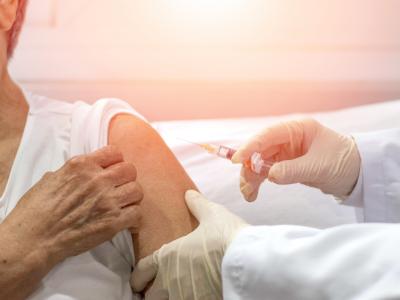COVID-19 not linked to poor outcomes in pregnant women, study finds
Pregnant women hospitalized with COVID-19 had similar clinical illness and outcomes as nonpregnant women of reproductive age and did not pass the virus to their newborns, according to a retrospective study published yesterday in the International Journal of Infectious Diseases.
The researchers studied the electronic medical records of 28 infected pregnant women and 54 nonpregnant peers hospitalized in the Central Hospital of Wuhan, China, from Jan 15 to Mar 15.
They found no link between pregnancy and illness severity (odds ratio [OR], 0.73; 95% confidence interval [CI], 0.08 to 5.15; P = 0.76), virus clearance time (OR, 1.16; 95% CI, 0.65 to 2.01; P = 0.62), or length of hospitalization (hazard ratio, 1.10; 95% CI, 0.66 to 1.84; P = 0.71).
Two pregnant women (7.1%) had mild illness, while 24 (85.7%) had moderate pneumonia, similar to nonpregnant women (53 women, 98.1%). Two pregnant women (7.1%) and one nonpregnant woman (1.9%) had severe pneumonia. Nonpregnant women were more likely to report fever and cough at hospital admission than pregnant women, some of whom reported abdominal pain.
Twenty-two women had 23 live births (one set of twins), 17 (60.7%) of them via cesarean section and five (17.9%) vaginally. None of the newborns were infected with the novel coronavirus. Four women had first- or second-trimester abortions over concerns about possible side effects from drugs, radiologic examinations, and the coronavirus on the fetus, and two were still pregnant when the study period ended.
Median age of the pregnant women was 30 years, versus 31 in non-pregnant women.
Apr 27 Int J Infect Dis study
Recommended PPE may not protect emergency department workers
A simulation showed contamination of healthcare workers' skin, hair, and shoes after performing endotracheal intubation, despite wearing recommended personal protective equipment (PPE), according to a research letter published yesterday in JAMA.
In the simulation, which took place in an emergency department in Israel, researchers aimed to determine personnel exposure to respiratory droplets generated during the provision of standard care for COVID-19 patients in respiratory distress. They used an atomizer and an invisible fluorescent compound as a marker of contamination to simulate adult and child scenarios involving respiratory droplet generation from coughing.
Personnel wore N95 respirators, eye protection, isolation gowns, and gloves, as recommended by the US Centers for Disease Control and Prevention (CDC) and the World Health Organization for aerosol-generating procedures.
One scenario involved a 74-year-old man with fever, shortness of breath, and declining oxygen levels who needed endotracheal intubation and an intravenous cannula. The pediatric scenario was similar. Two doctors and two nurses participated in each scenario. To avoid aerosol generation, bag-mask ventilation before intubation was allowed only when preoxygenation was inadequate.
Ultraviolet light revealed fluorescent markers on 7 of the 8 participants' skin, 6 on the neck, and 1 on an ear. All had fluorescent markers on their hair, and 4 on their shoes.
"The findings suggest that the current recommendations for personal protective equipment may not fully prevent exposures in emergency department settings," the authors said. "Clothing that covers all skin may further diminish exposure risk."
In an editorial in the same journal, David Weissman, MD, Marie de Perio, MD, and Lewis Radonovich, Jr, MD, of the CDC said that the findings highlight the importance of hand washing and using face shields during invasive procedures.
"Loose-fitting powered air-purifying respirators provide both high-level respiratory protection, as well as extensive facial and hair covering, and could be an effective and convenient alternative," they wrote.
Apr 27 JAMA research letter and editorial
COVID-19 restrictions tied to less flu activity in Taiwan, Singapore
Two new research letters in Emerging Infectious Diseases show decreased influenza activity in Taiwan and Singapore in light of restrictions placed in both countries to curb the spread of COVID-19.
Because of its previous experience with SARS (severe acute respiratory syndrome, also caused by a coronavirus), the government of Taiwan took early and swift action against COVID-19, with citizens avoiding gatherings, maintaining physical distance, wearing masks, practicing hand and respiratory hygiene, monitoring their temperatures, and quarantining when appropriate, the authors said.
"Although the success of these measures for limiting COVID-19 transmission remains to be determined, nationwide surveillance has shown the rapid decline of influenza activity during the first 12 weeks of 2020 (through March 21) in Taiwan," the authors said. Flu activity was significantly lower than during the same period in 2019.
In Singapore, influenza-like illness for 2020 before and after COVID-19 measures were taken was compared to three previous flu seasons.
"Percentage influenza positivity decreased by 64% (p = 0.001) and estimated daily number of influenza cases decreased by 76% (p = 0.002) in epidemiologic weeks 5–9 of 2020 compared with the preceding years," the authors wrote.
Apr 27 Emerg Infect Dis Taiwan letter
Apr 27 Emerg Infect Dis Singapore letter










